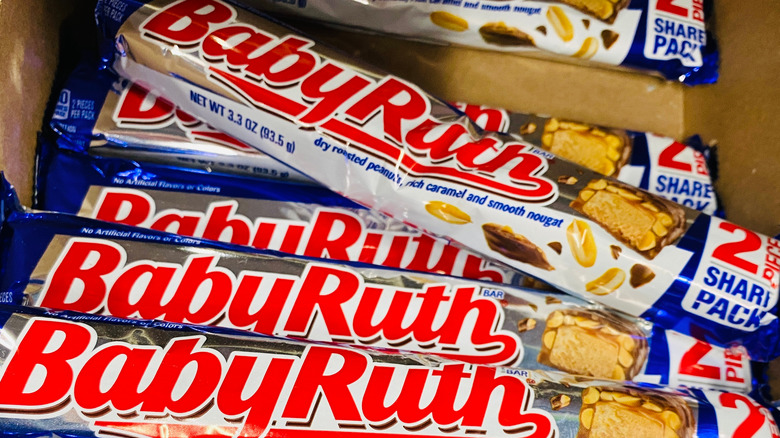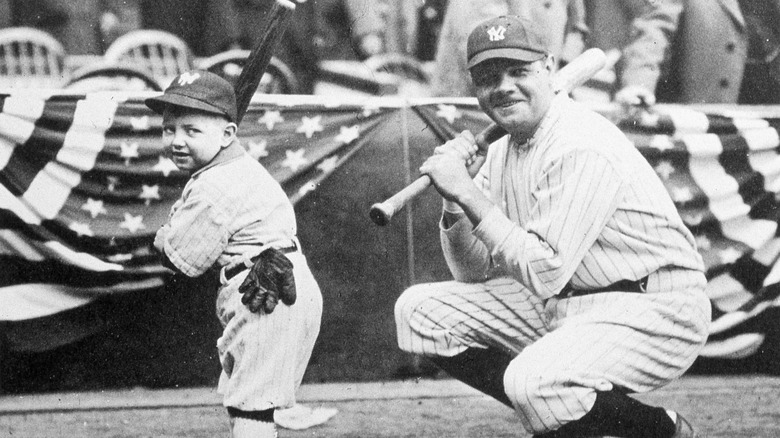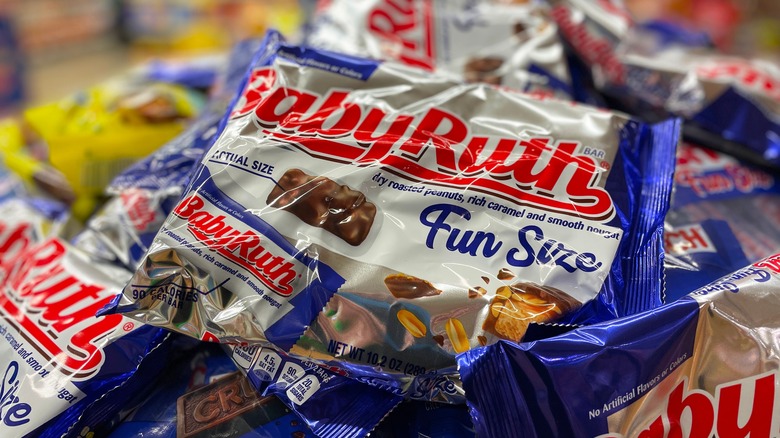The 1920s Dispute Between Babe Ruth And Baby Ruth Candy
Baby Ruth chocolate bars hold icon status among American candy, created in 1921 by the Curtiss Candy Company. It was a reincarnation of the candy maker's Kandy Kake confection, according to the History Channel, and the new ingredients weren't the only change. It also received a new name, one that jettisoned the candy bar to new heights.
By 1926, the Baby Ruth candy bar was wracking up million-dollar monthly sales figures and expanding its factory to the largest of all similar facilities worldwide. The fad became an enduring part of candy lore, and the name even adorned a Ford Thunderbird NASCAR-wining race car driven by Jeff Gordan, notes NBC Sports. It's been baked into cookies and swirled into ice cream and still fills many a trick-or-trick bag every October.
But the Baby Ruth name comes with more than its fair share of controversy. Given that it contains a single-letter variation from America's 1920s heartbeat of baseball, Babe Ruth, the candy bar's sweet success left a sour taste in its wake. The Major League Baseball star eventually stepped in, only to be accused of copyright infringement by the company using his name.
The real Ruth pushes back
So how could a candy company get away with blatantly co-opting the name of a celebrity as famous as Babe Ruth? It was the 1920s, so perhaps lawsuits weren't as commonplace. But there was a limit to how much George Herman Ruth Jr., aka Babe Ruth, would tolerate.
The affectionately nicknamed "King of Swing" fought back by attempting to create his own candy company and product. He advertised it as "Babe Ruth's Own Candy," verified by a photo of him in his official team uniform, explains the History Channel. The would-be company bore his legal name, the George H. Ruth Candy Company, with a proposed registration of "Ruth's Home Run Candy." Seems pretty straightforward — but no such luck; Curtiss the Candy wasn't giving up those monthly millions so quickly.
The company claimed copyright infringement, even though the Babe Ruth moniker was basically a household name by that point. A Pennsylvania State University article on the history of candy digs deeper into the claim, noting that Curtiss Candy disputed Ruth's fame at the time the product launched. But by 1921, Ruth received massive amounts of press as a star player for the New York Yankees and was already breaking home-run records.
Curtiss Candy was not dissuaded and stepped up with yet another claim, one that's hard to prove, and very few people actually believed it.
A baby named Ruth
Former President Grover Cleveland, who served two terms in office during the late 1800s, happened to have a young daughter named Ruth. The child died of diphtheria in 1904, at the age of 12, per the Penn State article. This was about seven years after her father's final presidential term and 17 years before the Baby Ruth candy bar hit the candy market. Yet, Curtiss Candy claimed to have named their bar after Ruth, President Cleveland's "baby."
Though it may be hard to comprehend, the "real" Babe Ruth, whose name very likely fueled the candy bar's remarkable success, lost the lawsuit in which he sought to use his own name. In 1931, in the case of George H. Ruth Candy Co. v. Curtiss Candy Co., the patent court ruled that Babe Ruth was trying to capitalize on the success of the candy bearing his professional name. The bar eventually ended up in the Nestle stable of fan-fave candies.


